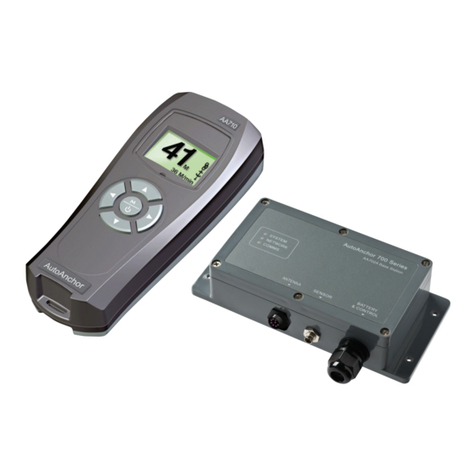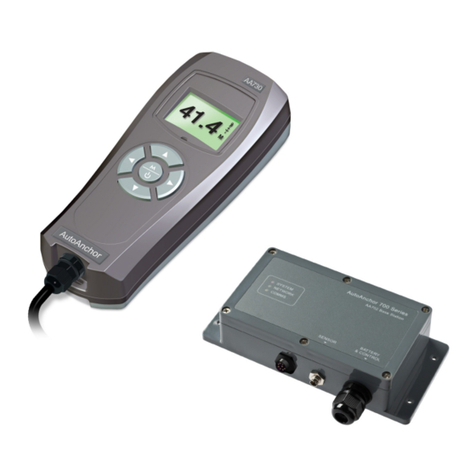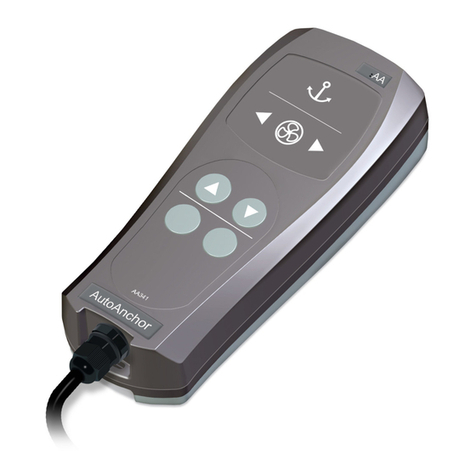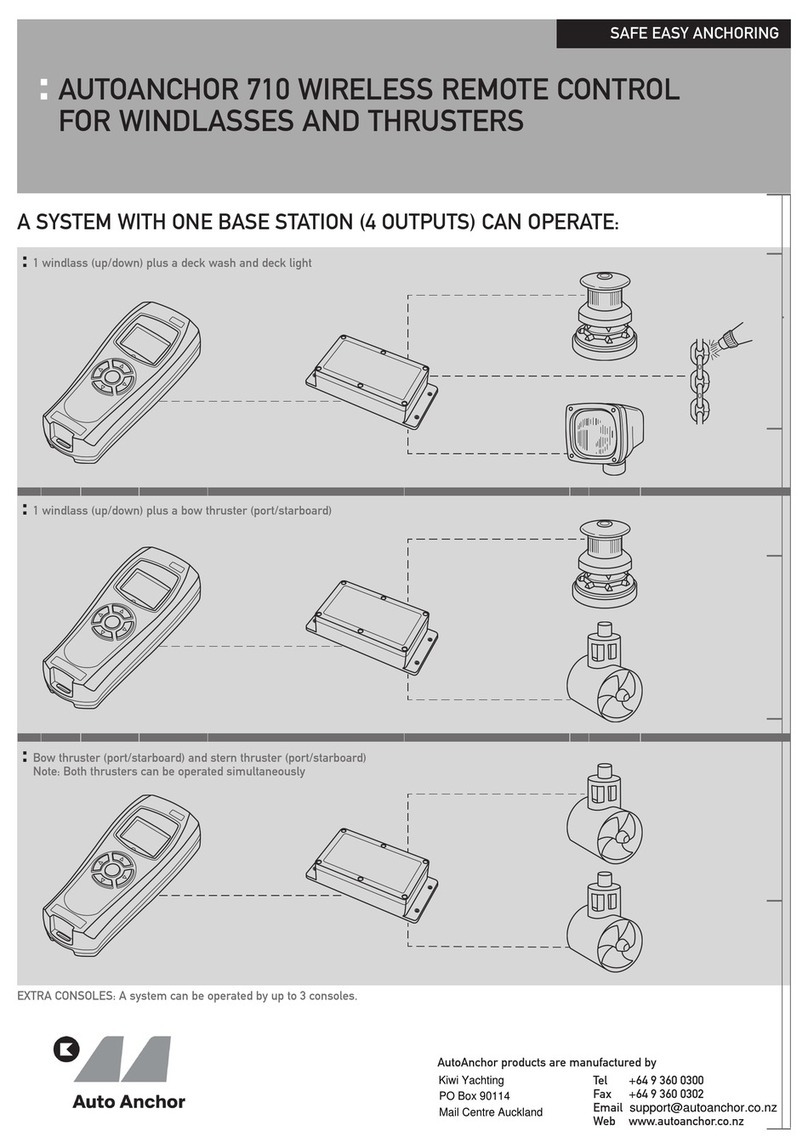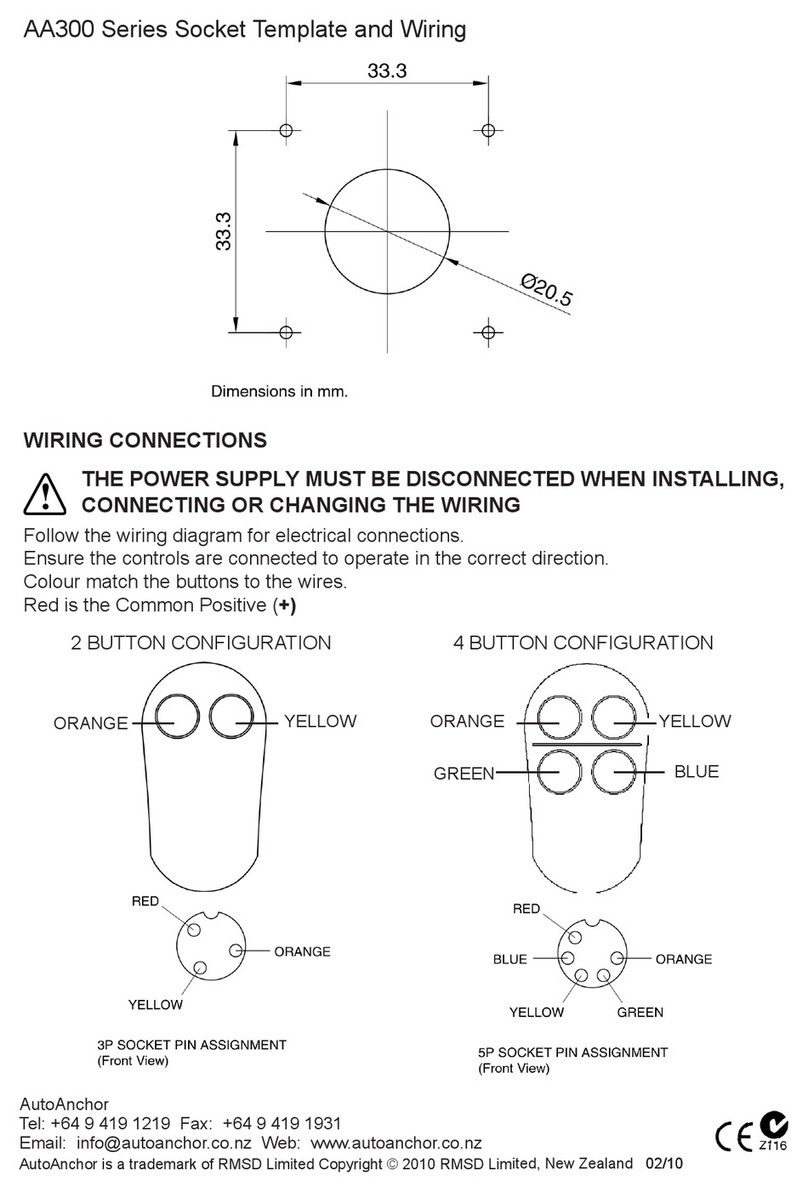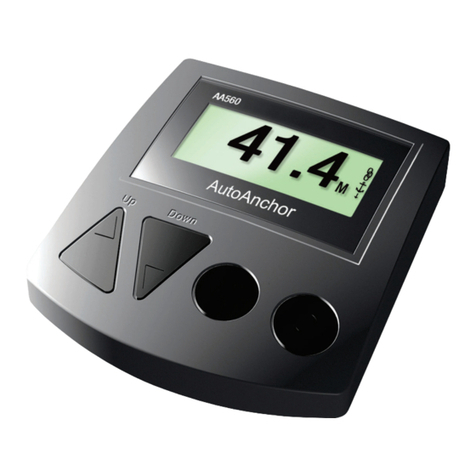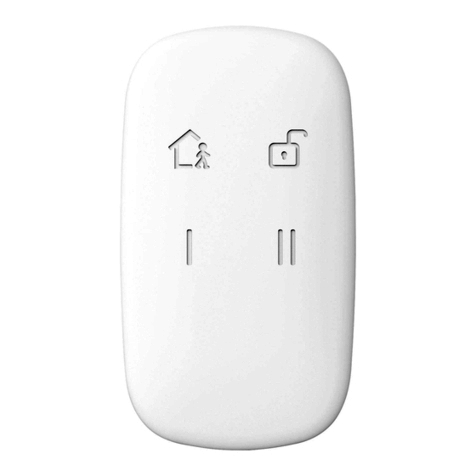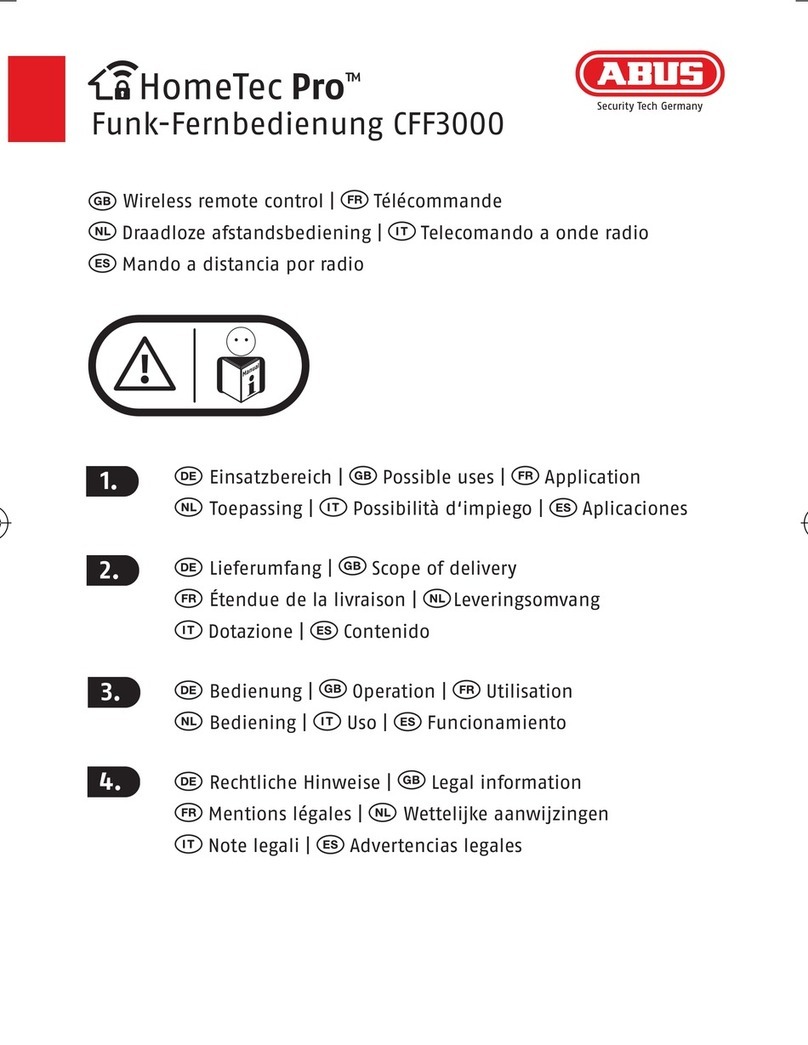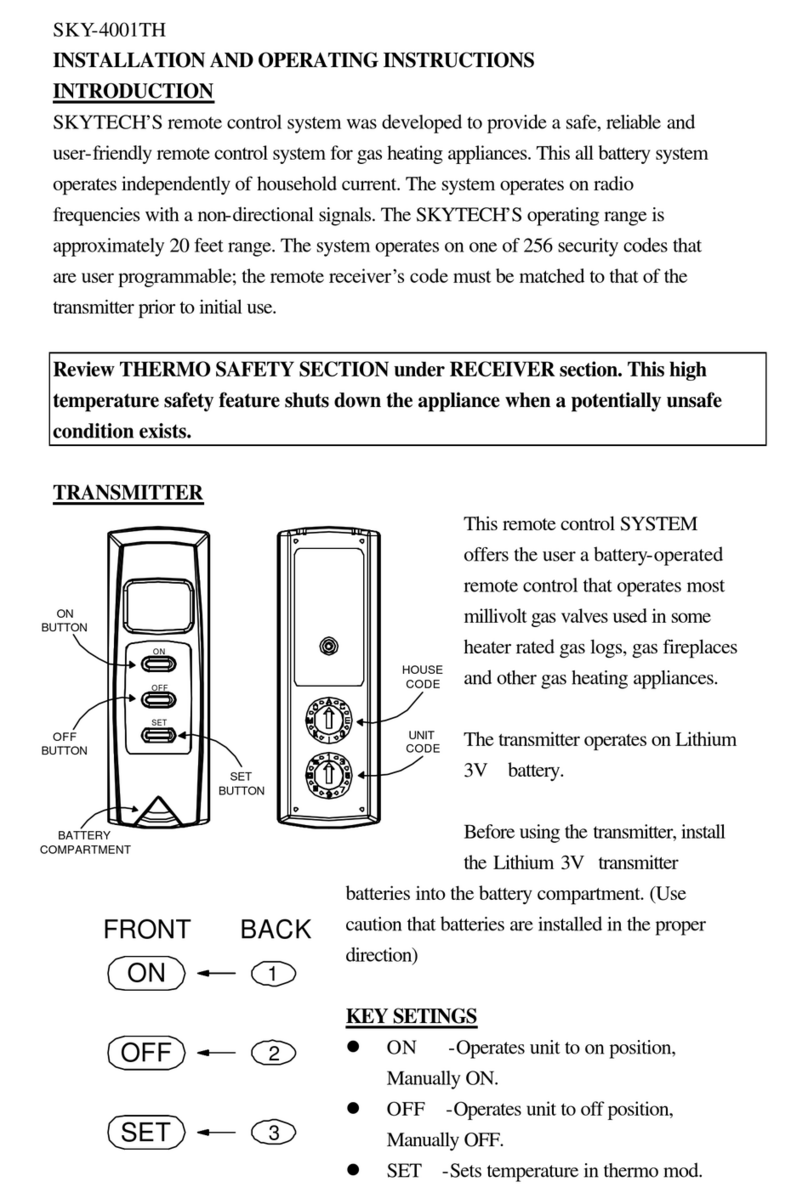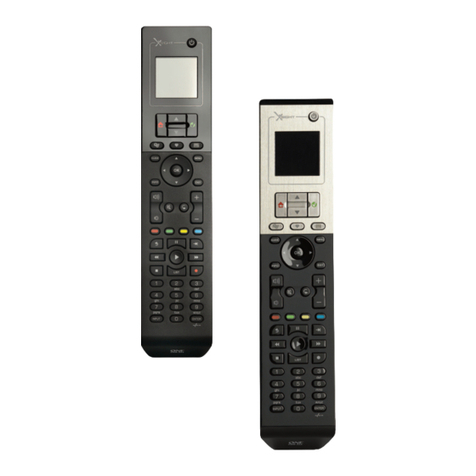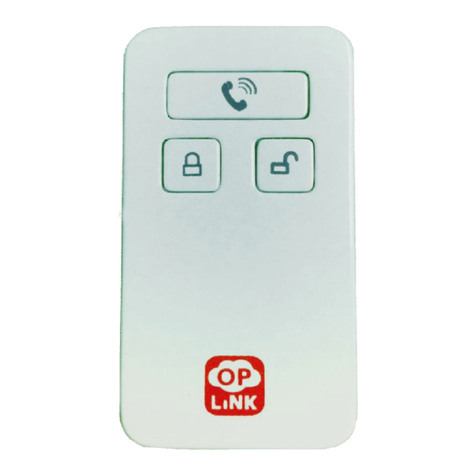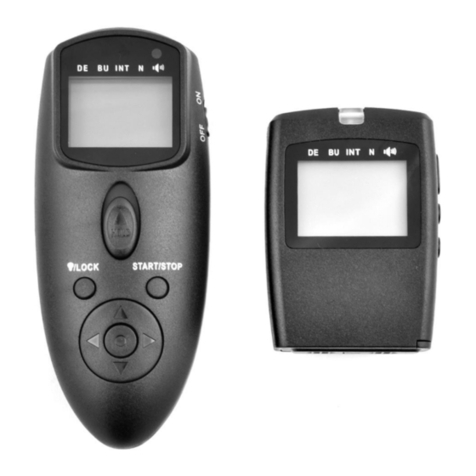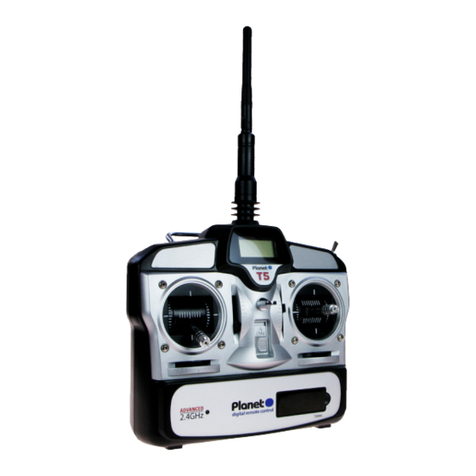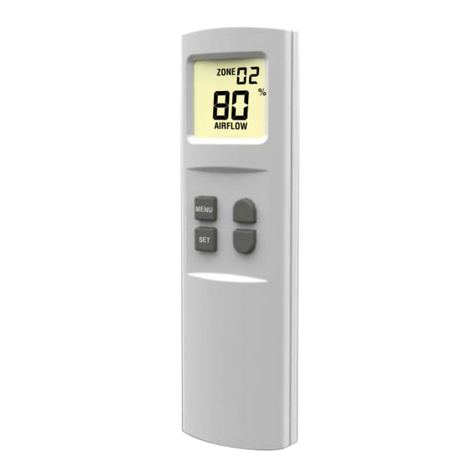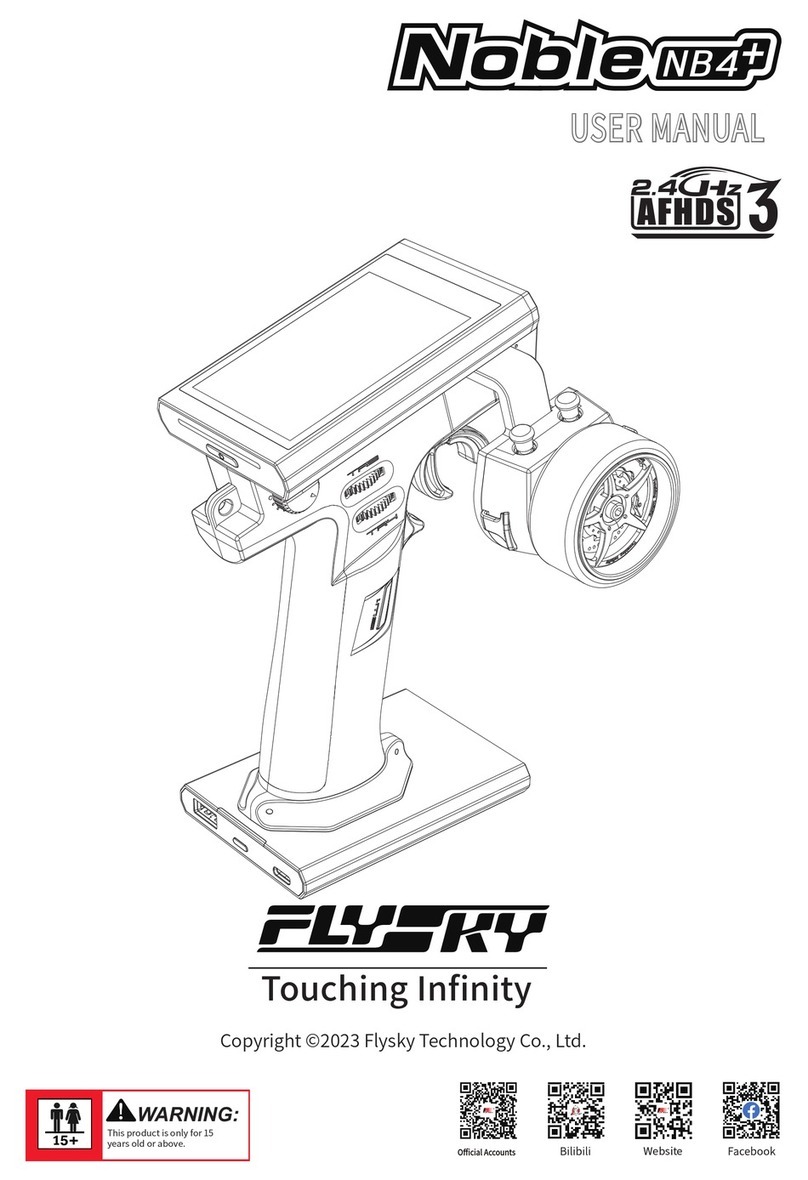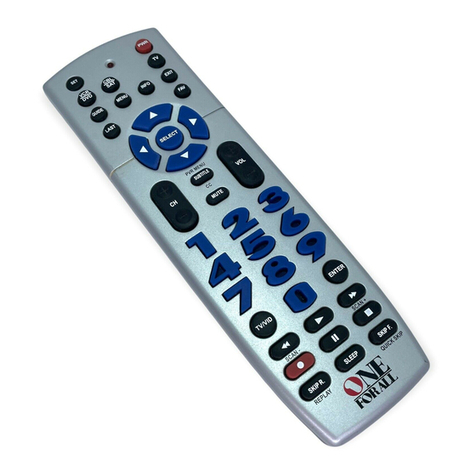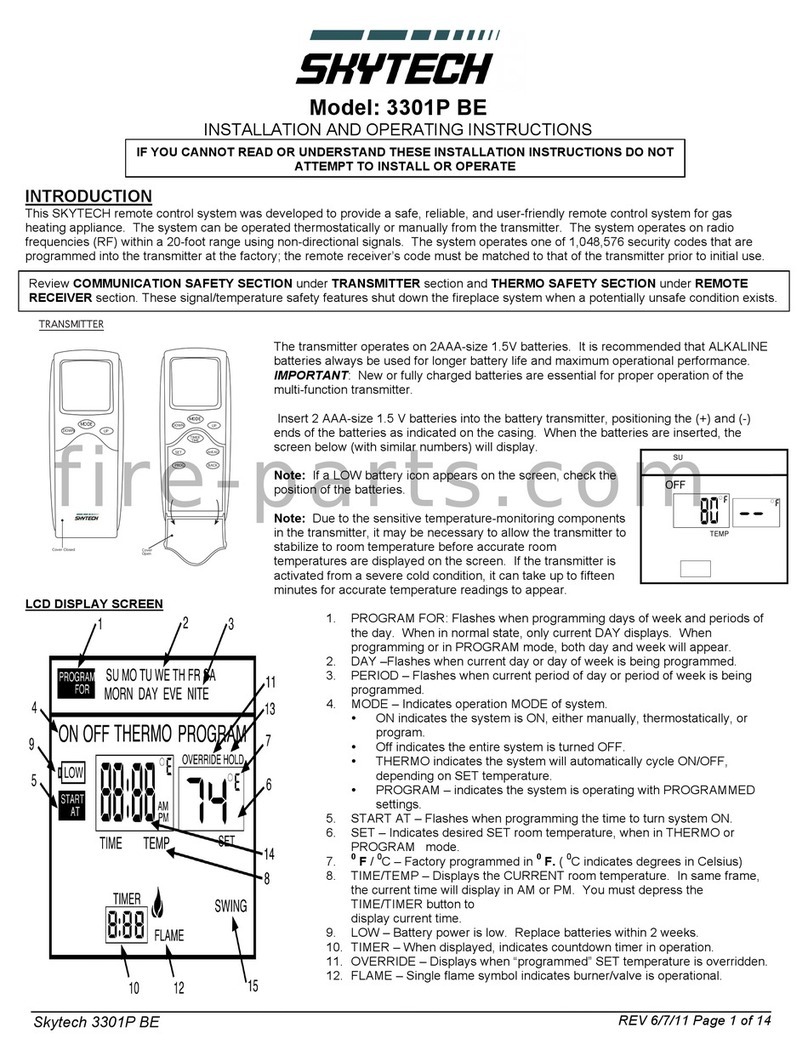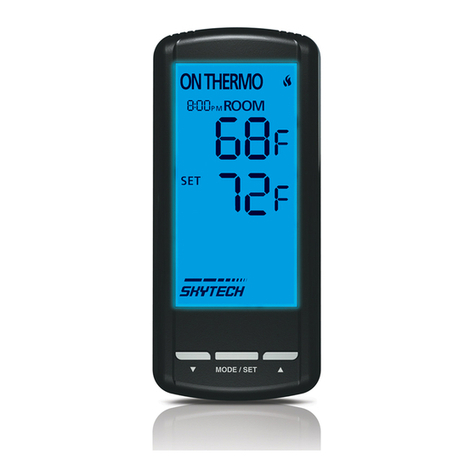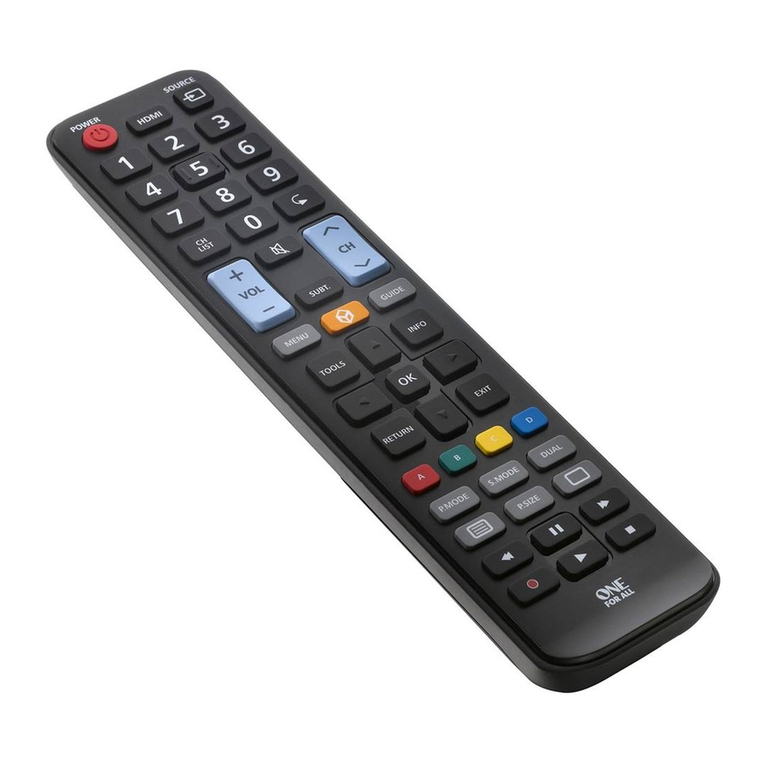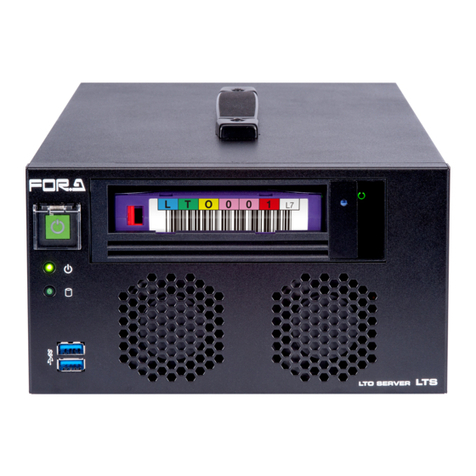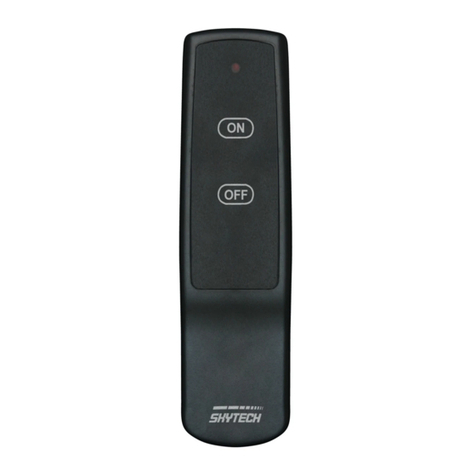Auto Anchor 560 User manual

AutoAnchor 560 Owner’s Manual
Part 1 Important Information 1
Part 2 Installation 3
Part 3 Set Up 13
Part 4 Operation 20
Part 5 Maintenance 25
Part 6 Troubleshooting 25
Index
TABLE OF CONTENTS
To the best of our knowledge the information in this manual was correct at the time
of printing. However, the AutoAnchor products are continuously being reviewed
and improved and product specifications may be changed without notice. The
latest product specifications may not be reflected in this version of the manual. The
documentation relating to the AutoAnchor products is created in the English language
and may be translated from English to another language. In the event of any conflict
between translated documents, the English language version will be the official version.

• The AA560 should only be installed by a qualified marine electrician. Do not
attempt to install the AA560 unless you are suitably qualified.
• This manual supports the use of the AA560 only. The appropriate manufacturer’s
instructions must be followed for the installation and use of the windlass it is set
up to control.
• There must be an alternative method available to operate the windlass.
• The AA560 can be fitted to most vertical windlasses. A horizontal windlass may
require a sensor holder or a custom designed sensor which is not included in the
standard pack. Check with your supplier or the AutoAnchor manufacturer.
• The AA560 must be fitted to a windlass with a dual direction control box or
solenoid pack.
• Information for installation and operation of the AA560 is supplied, including
pre-set windlass profile lists, wiring diagrams, the Owner’s Manual and
the Quick User Guide. All documents must be left on board for the owner.
• Non compliance with the instructions could impair the windlass and the
AA560 operation, and could result in personal injury and/or damage to the boat.
• Non compliance with the instructions will negate the manufacturer’s warranty.
• The AA560 manufacturer and supplier accept no liability for personal injury or
property damage resulting from failure to follow the installation and operation
instructions or the use of the AA560 in a way that may cause accidents or
damage or that may violate the law.
• All the technical and cable specifications must be checked and adhered to.
• Wiring diagrams must be followed without modification.
• Before use the AA560 must be correctly set up for the windlass it is to control and
tested in a safe environment. The AA560 will not count correctly if the windlass
selection is wrong or the windlass is not standard (eg it is installed with a different
chainwheel or motor).
• All installations must be carried out in accordance with USCG, ABYC, NMMA and
BMEA requirements.
• When this product reaches the end of its useful life it must be disposed of in
accordance with local regulations.
PART 1 IMPORTANT INFORMATION
READ BEFORE INSTALLING OR USING THE AUTOANCHOR

ELECTROMAGNETIC COMPATIBILITY (EMC)
FCC Information:
This device complies with CFR47 Part 15 of FCC Rules for Class B equipment.
ESTI Information (CE):
This device meets the relevant standards set out in European Standard EN 60945:2002 for
maritime navigation and radio communication equipment and systems. These standards
are intended to provide reasonable protection against interference by other emission
generating products on the boat. Compliance with these standards is no guarantee that
interference will not occur in a particular installation. The installation instructions must be
followed to minimise the potential for interference.
Note: If shielded cable is not used for the sensor connections this will compromise the
EMC and may invalidate the warranty.
The AA560 console must be installed at least 3ft (1m) away from any transmission
equipment or cables carrying radio signals eg VHF radios, cables and antennas or radar
antennas; and at least 6ft (2m) away from any SSB equipment. AA560 cables must be
installed at least 1.5ft (500mm) away from such items.
Power Supply 12V/24V DC
Maximum Voltage 30V DC
Current Consumption 70mA
Output Maximum
Current Draw
12V DC: 4A
24V DC: 4A
Output Minimum
Current Draw
12V DC: 10mA
24V DC: 20mA
When connecting to a solid state switching or other low
current windlass drive eg a PLC or AC variable frequency drive
a dummy resistor load (Part #9515) may be required.
IP Rating IP67 from the front provided the unit is mounted so the back is
protected from moisture.
Operating Temperature
Range
23oF to 140oF (-5oC to 60oC)
Sensor Compatible with all AutoAnchor sensors, reed switches and
some proximity switches.
Rode - Chain Only Stainless or galvanised steel.
Rode - Rope and Chain Must have a minimum of 10ft (3 m) of chain. Chain must be
galvanised steel. Rope should be a good quality, nylon anchor
rope. Type 66 or equivalent.
DC windlasses require a dual direction solenoid
TECHNICAL SPECIFICATIONS AA560

PART 2 INSTALLATION
2.1 MAGNET AND SENSOR INSTALLATION
PLEASE READ BEFORE COMMENCING INSTALLATION
Correct magnet and sensor installation is critical for successful AutoAnchor
operation.
The AutoAnchor can be installed on vertical windlasses, drum winches and most
horizontal windlasses. Installation differs depending on the windlass type and on the
rode (all-chain or rope and chain). Please follow the instructions for your windlass
and rode. If it is not possible to comply with these instructions please check with the
AutoAnchor manufacturer or your supplier for other options or if you are not sure how to
proceed.
2.1.1 MAGNET INSTALLATION OVERVIEW
Check before starting: Your chainwheel may be prefitted with a magnet or predrilled
ready for you to fit the magnet.
Magnet Polarity: Not relevant when using the grey AA sensor (#9067) or a reed switch
sensor. If retrofitting, using the black AA sensor (#9008) the south pole (marked side) of
the magnet must face the sensor.
Magnet Seal: Insert the magnet into the hole and cover it with a minimum of 1mm of epoxy
to protect it against corrosion. See Fig 1 on page 6.
Magnet Size and Position: Refer to the instructions for your specific windlass type.
2.1.2 SENSOR INSTALLATION OVERVIEW
Vertical Windlasses: The sensor is fitted in the deckplate. Some deckplates are predrilled
for the sensor. Others have a dimple or mark to show where the sensor should be fitted.
If the windlass is not factory drilled, drill a hole 10.3mm (13/32”) diameter through the
windlass deckplate. See the instructions for your specific windlass type.
+RUL]RQWDO:LQGODVVHV6RPHWLPHVLWLVQRWSRVVLEOHWR¿WWKHVHQVRUWRDKRUL]RQWDO
ZLQGODVVRULWPD\QHHGWREH¿WWHGE\WKHZLQGODVVPDQXIDFWXUHU%HIRUHVWDUWLQJ
FKHFNZLWKWKH$XWR$QFKRUPDQXIDFWXUHURUVXSSOLHUWKDWLWLVSRVVLEOHWR¿WWKH
VHQVRUWR\RXUZLQGODVV<RXPD\QHHGDVSHFLDO¿WWLQJ
Drilling the Deck: Before drilling into the deck, ensure there is nothing below the deck that
could be damaged and that any hole you drill will not weaken the boat’s structure. Drill a
hole 10.3mm (13/32”) diameter through the deck. Ensure this hole is directly in line with the
sensor hole in the deckplate.

Part #9507 Male Field Connector
Part #9508 Female Field Connector
If there is no plug on the sensor or console cable attach the AA field
connector to the wires and use the connecting cable as above.
2.1.3 PLUG AND PLAY SENSOR CABLE
The AutoAnchor plug and play sensor extension cable is 2 core tinned shielded cable. It
must be used to connect the sensor to the console unit. This cable is shielded and ensures
the product meets the EMC requirements.
Ensure the connectors are firmly screwed together.
The warranty does not apply if the sensor cable plugs are removed.
The sensor cable and the console sensor cable are fitted with female plugs.
Sensor connecting cable with a male plug at each end is available in the following lengths:
6.5 m (21.33 ft) Part #9500
10 m (32.81 ft) Part #9501
15 m (49.21 ft) Part #9502
20 m (66.62 ft) Part #9503
25 m (82 ft) Part #9504
35 m (114.83 ft) Part #9514
AutoAnchor
AA560
Console
Up Down
Sensor
Chainwheel
Sensor Connecting Cable
Fitting the Sensor: Do not force the sensor into the hole. Hammering the sensor head
can damage the internal electronics. Ensure the sensor head is positioned so that it will not
be hit by the chainwheel during windlass operation and that it is at least 300mm (1ft) away
from the battery and motor cables. Secure the sensor using a good quality neutral cure
silicone or a strong adhesive eg. Sikaflex 291 or 3M 5200.
Field Connectors
Connecting 2 cables together:
If you need to extend the cable length - 2 cables can be joined
together using Part #9510 Gender changer.

Dual Installation
Use the T junction connector Part #9506 and the 2m (Male/Female) extension cable Part
#9505.
2.1.4 REED SWITCH SENSORS
Some windlasses are supplied pre-fitted with a reed switch sensor. Reed switch sensors
must have a 10mm x 8mm magnet (#9061) and the gap between the reed switch sensor
and the magnet must be a minimum of 3mm and a maximum of 5mm. This sensor requires
a field connector.
The AutoAnchor will operate with a reed switch sensor for all-chain rode. If using rope/
chain rode the reed switch sensor provides a reasonably accurate count of rode deployed
but on retrieval the display may be incorrect because it cannot allow for the stretch in the
rope.
For an accurate rope and chain count, the reed switch sensor should be replaced with the
AA grey sensor (#9067).
2.1.5 PLUG AND PLAY SENSOR TUNING
When the AutoAnchor is completely installed the sensor must be tuned. See the
instructions on page 21.
Part
#9506
AutoAnchor
AA560
Console
Up Down
AutoAnchor
AA560
Console
Up Down
Chainwheel
Sensor
Part
#9505

Magnet Fit: Drill a hole 10.3mm (13/32”) diameter and 9.5mm (3/8”) deep to fit the magnet
in the underside of a spoke in the bottom of the chainwheel. Cover the magnet with a
minimum of 1 mm epoxy. The magnet must be aligned with the sensor. See Fig 1.
2.1.6 INSTALLATION VERTICAL WINDLASS - CHAIN ONLY
Magnet Size: Standard size is 10mm x 8mmm (#9061). This may be replaced with the
smaller 6mm x 4mm (#9009) magnet if required for your windlass.
Gap Between the Sensor and Magnet:
Sensor Magnet Size Gap
AA Grey Sensor #9067 6mm x 4mm Minimum 3mm - Maximum 30mm
AA Grey Sensor #9067 10mm x 8mm Minimum 3mm - Maximum 50mm
AA Black Sensor #9008 All Magnets Minimum 3mm - Maximum 8mm
Reed Switch Sensor 10mm x 8mm Minimum 3mm - Maximum 5mm
Refer to the Overview Notes on page 3 before starting installation.
Sensor Connection: The AutoAnchor plug and play sensor extension cable must be
used to connect the sensor to the console unit. Ensure the connectors are firmly screwed
together. See the information on page 4.
Loose cable should be tied in place with cable ties and kept clear of chain.
Sensor Position: The AA black sensor and the reed switch sensor must be fitted direclty
in line with the magnet in the chainwheel. See Fig 1 above. The AA grey sensor may be
fitted up to 20mm out of alignment. The gap between the sensor and magnet must be as
per the table below.
Fig 1 - All sensors
Seal with minimum 1mm epoxy.
Magnet
Sensor
Chainwheel
Deckplate
Note: If it is not possible to
align the sensor and magnet
exactly the AA grey sensor may
be fitted up to 20mm out of
alignment. The AA black sensor
and the reed switch sensor must
be directly aligned.

Magnet Fit: Some windlasses are predrilled and others need a special fit. Please check
with your supplier. The usual fit is as follows: Drill a hole 10.3mm (13/32”) diameter and
9.5mm (3/8”) deep into a spoke in the top of the chainwheel. Cover the magnet with a
minimum of 1mm epoxy. The magnet and sensor must be aligned so that the anchor rode
passes between them.(See Figs 2 & 3).
Sensor
Magnet
Fig 2 Fig 4
Seal with minimum 1mm epoxy.
Magnet
2.1.7 INSTALLATION VERTICAL WINDLASS - ROPE & CHAIN
For an accurate rope and chain count, the rode must run between the sensor and
magnet. If your windlass is prefitted with a magnet in the bottom of the chainwheel you
need to remove it and fit a new magnet in the top of the chainwheel. Refer to Figs 2-4.
Magnet Size: 10mm X 8mm magnet (#9061). An 8mm x 6mm magnet (#9052) may be
used on smaller windlasses. Check with your supplier.
Sensor Position: The sensor must be fitted into the deckplate within the sensor position
range at the stern end of the windlass (See Fig 5). It must also be aligned with the magnet
so that the rode passes between the sensor and the magnet. The centre of the magnet
and the centre of the sensor may be up to 10mm out of direct alignment. (See Fig 3). The
gap between the sensor and magnet must be as per the table below.
Chainwheel
Deckplate
Fig 3
Sensor & Magnet may be up to
10mm out of direct alignment
10mm
Sensor
Magnet
Sensor
Magnet
Sensor Position
Range
Fig 5
90o
Bow
Stern
Rode
Anchor
Locker
Chainwheel
Sensor Position Rope & Chain Vertical Windlasses
Gap Between the Sensor and Magnet
Sensor Magnet Size Gap
AA Grey Sensor #9067 8mm x 6mm Minimum 30mm - Maximum 44mm
AA Grey Sensor #9067 10mm x 8mm Minimum 35mm - Maximum 50mm
Refer to the Overview Notes on page 3 before starting installation.
Sensor Connection: The AutoAnchor
plug and play sensor extension cable
must be used to connect the sensor
to the console unit. Ensure the
connectors are firmly screwed together.
See the information on page 4.
Loose cable should be tied in place
with cable ties and kept clear of
chain.


Before starting check with the AutoAnchor manufacturer, or supplier, that it is
SRVVLEOHWR¿WWKHVHQVRUDQGPDJQHWWR\RXUKRUL]RQWDOZLQGODVV
For an accurate rope count the rode must run between the sensor and magnet. On a
horizontal windlass the magnet and sensor must be fitted by the windlass manufacturer.
If it is not possible to have the sensor and magnet fitted to achieve this you can use the
chain only horizontal windlass installation above. This provides an accurate count of
rode deployed but during retrieval the display may be incorrect because it cannot
allow for the stretch in the rope.
2.1.9 INSTALLATION HORIZONTAL WINDLASS - ROPE & CHAIN
Gap Between the Sensor and Magnet:
Minimum 5mm and maximum 40mm.
7KHPDJQHWDQGVHQVRUPXVWEH¿WWHd so that the gap remains consistent as the
winch turns.
Magnet Installation:
Size: 10mm x 8mm magnet (#).
The magnet can be mounted on the main shaft or on the side of the drum. See Figs 8 and
9. If mounted on the side of the drum, position it close to the inside to reduce the
peripheral speed of the magnet. Fix the magnet into position with epoxy ensuring it is
completely sealed to prevent corrosion.
Sensor Installation
The Grey 3 wire AutoAnchor sensor (#9067) is recommended but a proximity sensor may
be used. Every installation is different so this manual can provide guidelines only. The AA
sensor holder #, or a customised sensor holder, will be required to ensure the
sensor remains in position and the gap is consistent between the sensor and magnet
during operation.
2.1.10 INSTALLATION DRUM WINCHES
Sensor Connection: The AutoAnchor plug and play sensor extension cable must be
used to connect the sensor to the console unit. Ensure the connectors are firmly screwed
together. See the information on page 4.
Loose cable should be tied in place with cable ties and kept clear of chain.
For drum winch set up and operation, refer to page 19.
Magnet
on side of
drum
Magnet
on shaft
Sensor
Sensor
Fig 8 Fig 9
Magnet
Sensor
Fig 7
OD
ID

2.2 CONSOLE INSTALLATION
Choose a position where the operator will be able to see the anchor and windlass when
using the AA560.
Mount on a flat surface at least 3ft (1m) away from any equipment or cables carrying
radio signals eg VHF radios, cables and antennas or radar antenna and at least 6ft (2m)
away from any SSB equipment. The front of the console is waterproof but the cable boot
on the back is designed to breathe. Mount the console so that the back is protected from
moisture. Refer to the drilling template to drill the 4 holes to mount the console. Do not
use sealer or glue. The rubber grommets will seal the unit. Do not use metal studs, nylon
bolts are supplied. These should be hand tightened only.
2.2.1 MULTIPLE CONSOLE INSTALLATION
Up to 3 AA560 consoles can be installed to provide multiple control stations. The AA560
can also be installed with other windlass control stations eg foot switches, remote controls
and other AutoAnchor products. T-adapters and 2m extension cables are available for
multiple installations. Refer to the wiring diagrams and pages 4 and 5 for details. If you
are uncertain how to proceed contact your supplier.
Multiple battery bank negative terminals must be permanently connected together to
become the common negative return (ground).
Power supply to the AA560 must be from the windlass control circuit, along with all other
windlass controls eg. toggle switch, remote switches, deck switches, other AutoAnchor
devices. Power supply must not be from the motor positive near the windlass.
12V or 24V DC power supply is required.
Check battery polarity before connecting power.
5HIHUWRWKHZLQGODVVPDQXIDFWXUHU¶VVSHFL¿FDWLRQV for fuse/breaker, isolator and main
power cable specifications. Ensure any fuse/breaker on the control circuit has a rating
applicable to the current loads connected to the outputs. (AA560 Output maximum is 4
Amps). An additional isolating switch should be installed for controls if the main breaker or
isolator is not readily acessible from the helm.
THE POWER SUPPLY MUST BE DISCONNECTED WHEN INSTALLING,
CONNECTING OR CHANGING THE WIRING
2.3 POWER SUPPLY

2.4 VOLTAGE LEVELS
Neither the windlass nor the AutoAnchor will operate with insufficient power. (See minimum
voltages below). Batteries must be properly maintained and charged and all connections
and wires must be of good quality and the correct gauge to prevent voltage drop.
Minimum Voltage Required 12V DC System 24V DC System
Minimum voltage required to start windlass
operation.
10V DC 20V DC
If the windlass is already operating, this is the
minimum voltage required to continue operating.
6V DC 12V DC
CABLE SPECIFICATIONS
All battery and motor cables must be ring type, insulated to prevent short circuits and
installed no closer than 1ft (300mm) away from the sensor head.
Total Length Cable Size
Cable from AA560 to the Power Supply and Solenoids
Less than 10m (33ft) 1.5mm2 (AWG16)
10m (33ft) - 20m (66ft) 2.0mm2 (AWG14)
20m (66ft) - 40m (132ft) 3.0mm2 (AWG12)
Cable from Motor Load Wires
Up to 30.5m (100ft) 1.0mm2 (AWG18)
2.5 WIRING
Interlock protection is included in the system. Do not fit diodes or interlock devices to
windlass outputs as these will prevent the system from operating correctly.
All main power conductors and terminations are to be installed according to the windlass
manufacturer’s specifications. Seal terminals against moisture by spraying with CRC
[3013] Soft Seal or CRC [2043] Plasticoat 70. Insulation must be used to protect all
terminals.
To reduce the potential for interference all cables must be located at least 1.5ft (500mm)
away from any equipment or cables carrying radio signals eg VHF or SSB radios, cables
and antennas or radar antennas.
Do not leave cables hanging loose, they must be tied in place with cable ties.

9083

3.1 USING THE AUTOANCHOR BUTTONS
Scroll: Menu/Numbers/Up/Down.
Mode/Select/Enter/Save.
On/Off/Escape or Back.
Hold together to access the Set up menu.
Hold for 2 seconds to disable the lock.
Hold for 2 seconds to return the AutoAnchor to the idle state.
PART 3 SET UP
DownUp
3.2 SET UP MENU OVERVIEW
Use to scroll through the menu.
Hold together to display the Set up menu.
The AutoAnchor must be turned off to access the Set up menu.
General
Diagnostics
Sensor
Up Solenoid
Down Solenoid
Load Wires
Battery
Windlass
Diagnostics
About
Windlass Set Up
Docking distance
Total rode length
Rode
Chain only
Chain per turn
Rope and chain
Preset
Chain per turn
Rope per turn
Drum Winch
Inside diameter
Outside diameter
Sensor
Standard
Motor Driven Reed
Gearbox ratio
Swap controls
General Set Up
Language
Units
Feet
Meters
Fathoms
Key Beep
Lock
Factory Defaults
2.0
V2

3.3 GENERAL SET UP
To Access General Set Up
Turn the AutoAnchor Off.
Hold together to display the Set Up menu.
Select General.
To Exit General Set Up
Exit to the Set up menu or hold for 2 seconds to exit
to the start screen.
Set Units
Select units.
Scroll to meters, feet or fathoms.
Save.
Return to General Menu.
Set Key Beep
Scroll to key beep.
Save key beep on or off.
Set Lock - For safety we recommend the lock be left on.
Scroll to lock.
Save lock on or off.
3.4 FACTORY DEFAULTS
Resetting the Factory Defaults clears all programmed
settings and logs.
To Reset Factory Defaults:
Turn the AutoAnchor off.
Hold together to access the Set up menu.
Select General.
Select Factory defaults.
Select No/Yes.
Yes - Apply the factory reset. The AutoAnchor will turn off.
Re-enter all your Settings.
No - Return to the General menu.
Hold the On/Off button down for 2 seconds to return the
AutoAnchor to the start screen.
Set Language
Select Language.
Scroll to the preferred language.
Save.
Return to General Menu.

3.5.1 To Access Windlass Set up
Turn the AutoAnchor Off.
Hold together to access the Set up menu.
Scroll to Windlass.
Select Windlass.
3.5 WINDLASS SET UP
For accurate counting you must set up the AutoAnchor with information for your windlass.
Record the settings for future reference.
3.5.2 Set Docking Distance
Defaut = 1.5m or 4ft. Minimum setting = 1m or 3.3ft.
Note: During retrieval the windlass stops at the docking distance.
Scroll to Docking distance.
Select docking distance.
Increase or decrease the docking distance.
Save and return to Windlass Setup.
Setting:
3.5.3 Set Total Rode Length
Add total length of chain plus total length of rope.
Defaut = 60m or 196ft. Minimum setting = 10m (33ft).
or OFF to operate as a counter only.
Scroll to Total rode length.
Select Total rode length.
Increase or decrease the value in meters or feet.
Save and return to Windlass Set up.
Setting:
3.5.4 Set Rode
Scroll to Rode.
Select Rode.
Select Chain only or Rope and chain and follow the
instructions below to enter the settings for the rode selected.
This is the length of chain that is released during one complete turn of the chainwheel.
The information for some windlasses is listed in Appendix 1. If your windlass is not listed
follow the instructions below to calculate the chain per turn.
3.6.1 Chain Per Turn
3.6 CHAIN ONLY RODE SET UP
Setting:

3.6.3 Calculating the Chain Per Turn
Step 1 Use adhesive tape to place a mark on the
chainwheel.
Step 2 Use adhesive tape to place a mark on the chain
coming out of the chain wheel.
Step 3 Use adhesive tape to place a mark on the deck
below the mark on the chain.
Step 4 Carefully release the chainwheel so that it can be
turned by hand to feed the chain out.
Step 5 Using the mark on the chainwheel as a guide, turn the
chainwheel one turn, causing the chain to be
released on to the deck.
Step 6 Measure the length of chain from the mark on the
deck to the mark on the chain.
Step 7 Enter this measurement (See below).
Chainwheel Mark
Chain Mark
Deck Mark
Distance to Measure
Select Chain per turn.
Enter the measurement. In mm or in metric inches
(depending on units selected). See the table
below for metric inch calculations.
Save and return to Rode Set up.
Exit to Windlass Set up.
3.6.2 To Enter the Chain per Turn for Chain Only Rode
Setting:
3.7 ROPE AND CHAIN RODE SET UP
Some rope and chain windlasses have the settings already entered in the AutoAnchor.
Refer to the Preset Windlass Profile List in Appendix 1. If your windlass is on the list
select “Use preset” to enter the Windlass profile.
If your windlass is not on the list:
You will need to enter information for the chain and rope per turn.
(See instructions on page 17).
Inches Metric Inches AutoAnchor Setting
(to 1 decimal point)
1/8 0.125 0.1
1/4 0.25 0.3
3/8 0.375 0.4
1/2 0.5 0.5
5/8 0.625 0.6
3/4 0.75 0.8
7/8 0.875 0.9
Metric Inches Conversion Table

3.7.1 Selecting Use Preset
Refer to the Preset Windlass Profile List list in Appendix 1.
Select Use Preset.
Select Windlass profile.
Scroll to the correct Windlass profile for your windlass.
Save and return to Windlass Set up. There are no
further settings.
Exit to Set up menu or hold for 2 seconds to return
to the start screen.
Setting:
This is the length of chain that is released during one complete turn of the chainwheel.
The chain per turn for some windlasses is listed in Appendix 1. If your windlass is not
listed, follow the instructions on page 16 to calculate it.
3.7.2 Chain per Turn for Rope and Chain Rode
Select Chain per turn.
Enter the measurement in mm or metric feet
(depending on the units selected). See the
table for metric inch calculations.
Save and return to Rode Set up.
3.7.3 To Enter the Chain per Turn
Setting:
3.7.4 Rope per Turn for Rope and Chain Rode
This is the length of rope that is released during one complete turn of the chainwheel. You
need to measure the length of rope pulled through for 10 turns and divide the result by 10.
See instructions below to calculate the rope per turn.
3.7.5 Calculating the Rope Per Turn
Step 1 Carefully release the chainwheel so that it can be
turned by hand to feed the rode out until you have
rope.
Step 2 As you did for the chain, use adhesive tape to mark
the chainwheel, the deck and the rope. (See the
instructions for the chain per turn above).
Step 3 Using the mark on the chainwheel as a guide, pull the
rope out by hand until the chainwheel has completed
10 turns.
Step 4 Measure the length of rope pulled, divide it by 10.
Step 5 Enter this measurement (See page 18).
Chainwheel Mark Chain Mark
Deck Mark
Distance to Measure

Select Rope per turn.
Enter the measurement in mm or metric inches
(depending on the units selected).
Save and return to Rode Set up. There are no further
settings.
Exit to Windlass Set up. Press twice to exit to the Set Up
menu or hold for 2 seconds to return to the start screen.
3.7.6 To Enter the Rope per Turn
Setting:
3.8.1 Motor Driven Sensors
To select the motor driven sensor:
Scroll to Sensor.
Select Sensor.
Scroll to Motor driven reed.
Select.
Scroll to Gearbox ratio.
Select Gearbox ratio.
Increase or decrease the Gearbox ratio.
Save and exit to the Sensor set up menu.
Exit to the Windlass set up menu or hold for
2 seconds to return to start screen.
3.8 SENSOR SET UP
Default setting: Standard - Applies to all AA sensors, reed switch
baseplate sensors and proximity sensors. The default setting
should only be changed if you are using a motor driven sensor. (See
below).
Note: The sensor is tuned to the system on first use. See page 21.
3.9 SWAP CONTROLS
Default setting: = Up and = Down
Some operators prefer to use the buttons so that
= Out and = In
Access the swap controls feature via the Windlass Set up Menu.
Turn the AutoAnchor Off.
Hold together to access the Set up menu.
Scroll to Windlass.
Select Windlass.
Scroll to Swap Controls.
Select Swap Controls.
Exit to the Windlass Set Up or hold for 2 seconds
to return to start screen.
Note: This feature can not be used to correct wiring errors.
Other manuals for 560
2
This manual suits for next models
1
Table of contents
Other Auto Anchor Remote Control manuals

